Accessibility Features for the Cisco IP Phone 6800 Series
The Cisco IP Phone 6800 Series Multiplatform Phones provide accessibility features for the blind, and the visually, hearing, and mobility impaired. Because many of these features are standard, they can be used by users with disabilities without requiring any special configuration.
In this document, the term phone support pages refers to the web pages that users can access to set up certain features.
Cisco is committed to designing and delivering accessible products and technologies to meet the needs of your organization. You can find more information about Cisco and its commitment to accessibility at this URL: http://www.cisco.com/go/accessibility
Cisco IP Phone 6821 Multiplatform Phones Hearing-Impaired Accessibility Features
Your phone comes with standard accessibility features that require little or no setup.
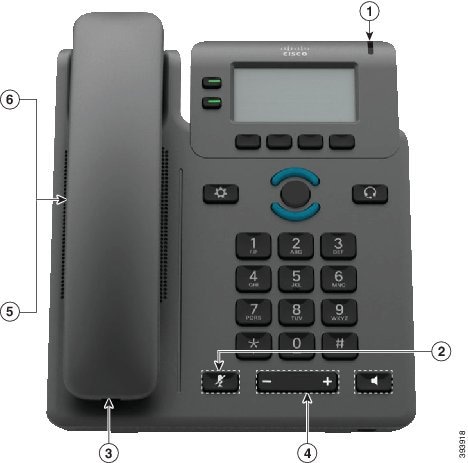
|
Item |
Accessibility Feature |
Description |
|---|---|---|
|
1 |
Visual message-waiting indicator |
This lighted strip is visible from all angles. Your phone also provides an audible message-waiting indicator. |
|
2 |
Visual notification of the phone state |
Use the Mute button to toggle the microphone on or off. When the microphone is muted, the mute icon flashes on the screen |
|
3 |
Inline-amplifier support (handset) |
Cisco IP Phone handsets support third-party inline amplifiers. You attach an amplifier to the handset and cord and it sits between the handset and the IP phone. |
|
4 |
Adjustable ringtone, pitch, and volume |
Your administrator can also change your settings. |
|
5 |
Hearing aid compatible (HAC) handset |
Supports these accessibility features:
|
|
6 |
Acoustic coupled TTY and TDD support (handset) |
Cisco IP Phones support these TTY and TDD features:
For information about setting up TTY, contact your administrator. |
Cisco IP Phone 6841, 6851, and 6861 Hearing-Impaired Accessibility Features
Your phone comes with standard accessibility features that require little or no setup.
To check which phone model you have, press Applications ![]() and select . The Product name field shows your phone model.
and select . The Product name field shows your phone model.
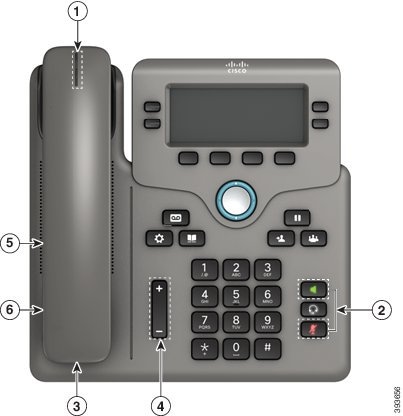
|
Item |
Accessibility Feature |
Description |
|---|---|---|
|
1 |
Visual message-waiting indicator (handset) |
This lighted strip is visible from all angles. Your phone also provides an audible message-waiting indicator. |
|
2 |
Visual notification of the phone state |
|
|
3 |
Inline-amplifier support (handset) |
Cisco IP Phone handsets support third-party inline amplifiers. You attach an amplifier to the handset and cord and it sits between the handset and the IP phone. |
|
4 |
Adjustable ringtone, pitch, and volume |
Your administrator can also change your settings. |
|
5 |
Hearing aid compatible (HAC) handset |
Supports these accessibility features:
|
|
6 |
Acoustic coupled TTY and TDD support (handset) |
Cisco IP Phones support these TTY and TDD features:
For information about setting up TTY, contact your administrator. |
Cisco IP Phone 6871 Multiplatform Phones Hearing-Impaired Accessibility Features
Your phone comes with standard accessibility features that require little or no setup.
To check which phone model you have, press Applications ![]() and select . The Product name field shows your phone model.
and select . The Product name field shows your phone model.
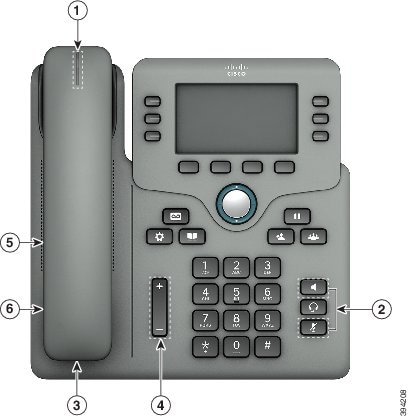
|
Item |
Accessibility Feature |
Description |
|---|---|---|
|
1 |
Visual message-waiting indicator (handset) |
This lighted strip is visible from all angles. Your phone also provides an audible message-waiting indicator. |
|
2 |
Visual notification of the phone state |
|
|
3 |
Inline-amplifier support (handset) |
Cisco IP Phone handsets support third-party inline amplifiers. You attach an amplifier to the handset and cord and it sits between the handset and the IP phone. |
|
4 |
Adjustable ringtone, pitch, and volume |
Your administrator can also change your settings. |
|
5 |
Hearing aid compatible (HAC) handset |
Supports these accessibility features:
|
|
6 |
Acoustic coupled TTY and TDD support (handset) |
Cisco IP Phones support these TTY and TDD features:
For information about setting up TTY, contact your administrator. |
Cisco IP Phone 6821 Multiplatform Phones Vision-Impaired and Blind Accessibility Features
Your phone comes with standard accessibility features that require little or no setup.
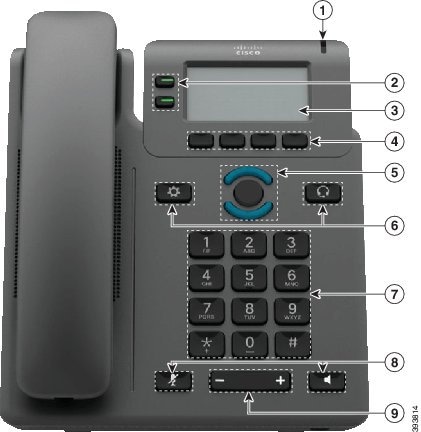
|
Item |
Accessibility Feature |
Description |
|---|---|---|
|
1 |
High-contrast visual and audible alert of an incoming call |
Alerts you to an incoming call. The light strip flashes during incoming calls and stays lit when a voicemail message is received. |
|
2 |
Line and feature buttons The line and feature buttons are on the left of the screen. |
Use line buttons to start, answer, or switch to a call on a particular line. Features, such as speed dial, line status, privacy, do not disturb (DND), and service URLs, can be assigned to feature buttons. Your administrator sets up programmable feature buttons on your phone. Colors indicate your phone's status:
|
|
3 |
Back-lit grayscale LCD screen with adjustable contrast |
Allows you to adjust your phone screen's contrast. |
|
4 |
Softkeys These are large buttons just below the LCD. |
Provide access to special functions. The functions are displayed on the LCD. |
|
5 |
Navigation Cluster (includes the Navigation buttons and the Select button) The Navigation cluster is located in the center of the phone below the softkeys. |
Use the Navigation up and down buttons to move up and down in the phone LCD. The Select button is in the center of the Navigation cluster. |
|
6 |
Applications and Headset button
|
Use the Applications to access functions on your phone. Use the Headset button to toggle the headset on or off. |
|
7 |
Standard 12-key layout |
Allows you to use existing or familiar key positions. Key 5 has a nib. |
|
8 |
|
Provide audible notification of the phone state:
|
|
9 |
Volume key This key is located below the keypad. |
Allows you to increase or decrease the ring volume or the sound through the handset, headset, or speakerphone. Press right on the rocker key to increase the volume. Press left on the rocker key to decrease the volume. |
Cisco IP Phone 6841, 6851, and 6861 Vision-Impaired and Blind Accessibility Features
Your phone comes with standard accessibility features that require little or no setup.
To check which phone model you have, press Applications ![]() and select . The Product name field shows your phone model.
and select . The Product name field shows your phone model.
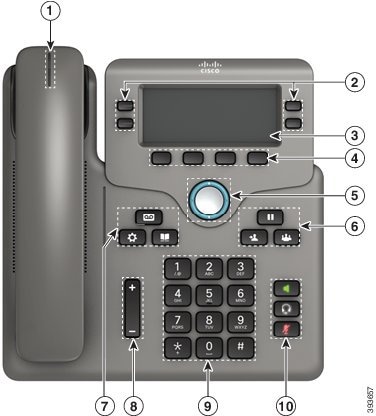
|
Item |
Accessibility Feature |
Description |
|---|---|---|
|
1 |
High-contrast visual and audible alert of an incoming call |
Alerts you to an incoming call. The handset light strip flashes during incoming calls and stays lit when a voicemail message is received. |
|
2 |
Line and feature buttons The line and feature buttons are on the left and right sides of the screen. |
Use line buttons to start, answer, or switch to a call on a particular line. Features, such as speed dial, line status, privacy, do not disturb (DND), and service URLs, can be assigned to feature buttons. Your administrator sets up programmable feature buttons on your phone. Colors indicate your phone's status:
|
|
3 |
Back-lit grayscale LCD screen with adjustable contrast |
Allows you to adjust your phone screen's contrast. |
|
4 |
Softkeys
|
Provide access to special functions. The functions are displayed on the LCD. |
|
5 |
Navigation Cluster (includes the Navigation ring and the Select button) The Navigation cluster is located in the center of the phone. |
Use the Navigation ring to move up and down in the phone LCD. The Select button is in the center of the Navigation cluster. |
|
6 |
Hold button, Transfer button, and Conference button
|
Allow you to use these functions on your phone. |
|
7 |
Messages button, Applications button, and Contacts button
|
Allow you to easily access your messages, applications, and contacts. |
|
8 |
Volume key This key is located to the left of the keypad. |
Allows you to increase or decrease the ring volume or the sound through the handset, headset, or speakerphone. Press up on the rocker key to increase the volume. Press down on the rocker key to decrease the volume. |
|
9 |
Standard 12-key layout |
Allows you to use existing or familiar key positions. Key 5 has a nib. |
|
10 |
|
Provide audible notification of the phone state:
|
Cisco IP Phone 6871 Multiplatform Phones Vision-Impaired Accessibility Features
Your phone comes with standard accessibility features that require little or no setup.
To check which phone model you have, press Applications ![]() and select . The Product name field shows your phone model.
and select . The Product name field shows your phone model.
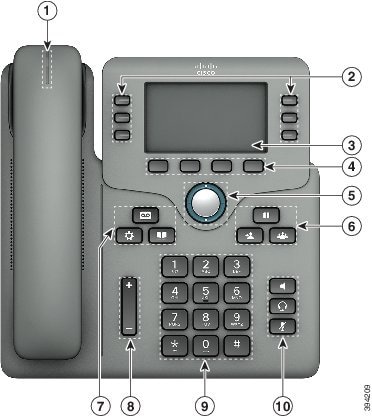
|
Item |
Accessibility Feature |
Description |
|---|---|---|
|
1 |
High-contrast visual and audible alert of an incoming call |
Alerts you to an incoming call. The handset light strip flashes during incoming calls and stays lit when a voicemail message is received. |
|
2 |
Line and feature buttons The line and feature buttons are on the left and right sides of the screen. |
Use line buttons to start, answer, or switch to a call on a particular line. Features, such as speed dial, line status, privacy, do not disturb (DND), and service URLs, can be assigned to feature buttons. Your administrator sets up programmable feature buttons on your phone. Colors indicate your phone's status:
|
|
3 |
Back-lit color LCD screen with adjustable brightness |
Allows you to adjust your phone screen's brightness. |
|
4 |
Softkeys
|
Provide access to special functions. The functions are displayed on the LCD. |
|
5 |
Navigation Cluster (includes the Navigation ring and the Select button) The Navigation cluster is located in the center of the phone. |
Use the Navigation ring to move up and down in the phone LCD. The Select button is in the center of the Navigation cluster. |
|
6 |
Hold button, Transfer button, and Conference button
|
Allow you to use these functions on your phone. |
|
7 |
Messages button, Applications button, and Contacts button
|
Allow you to easily access your messages, applications, and contacts. |
|
8 |
Volume key This key is located to the left of the keypad. |
Allows you to increase or decrease the ring volume or the sound through the handset, headset, or speakerphone. Press up on the rocker key to increase the volume. Press down on the rocker key to decrease the volume. |
|
9 |
Standard 12-key layout |
Allows you to use existing or familiar key positions. Key 5 has a nib. |
|
10 |
Headset button, Speakerphone button, and Mute button
|
Provide audible notification of the phone state:
|
Cisco IP Phone 6821 Multiplatform Phones Mobility-Impaired Accessibility Features
Your phone comes with standard accessibility features that require little or no setup.
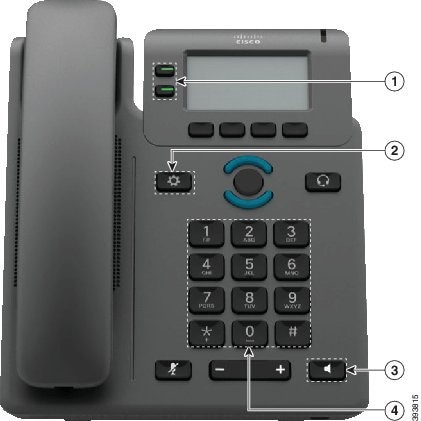
|
Item |
Accessibility Feature |
Description |
|---|---|---|
|
1 |
Lighted buttons |
Allow you to access the following features:
Indicate your phone's status:
|
|
2 |
Large button to access Applications |
Allow you to easily access your phone applications. Additional features are available with the softkeys. |
|
3 |
Built-in speakerphone |
Press the button to turn speakerphone on or off. |
|
4 |
Tactile-discernible buttons and functions, including a nib on Key 5 |
Allow you to easily locate your phone's keys. For example, Key 5 has a nib, which you can use to locate other key positions. |
Cisco IP Phone 6841, 6851, and 6861 Mobility-Impaired Accessibility Features
Your phone comes with standard accessibility features that require little or no setup.
To check which phone model you have, press Applications ![]() and select . The Product name field shows your phone model.
and select . The Product name field shows your phone model.
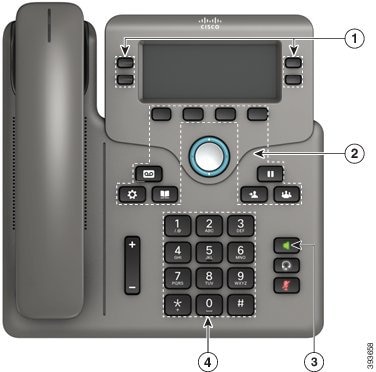
|
Item |
Accessibility Feature |
Description |
|---|---|---|
|
1 |
Lighted buttons |
Allow you to access the following features:
Indicate your phone's status:
|
|
2 |
Large buttons to access Applications, Messages, Contacts, Hold, Transfer, and Conference |
Allow you to easily access your phone applications, voice messages, corporate and personal directories, and calling features. |
|
3 |
Built-in speakerphone |
Indicates whether the speakerphone is on or off. When the speakerphone is on, the button is lit. |
|
4 |
Tactile-discernible buttons and functions, including a nib on Key 5 |
Allow you to easily locate your phone's keys. For example, Key 5 has a nib, which you can use to locate other key positions. |
Cisco IP Phone 6871 Multiplatform Phones Mobility-Impaired Accessibility Features
Your phone comes with standard accessibility features that require little or no setup.
To check which phone model you have, press Applications ![]() and select . The Product name field shows your phone model.
and select . The Product name field shows your phone model.
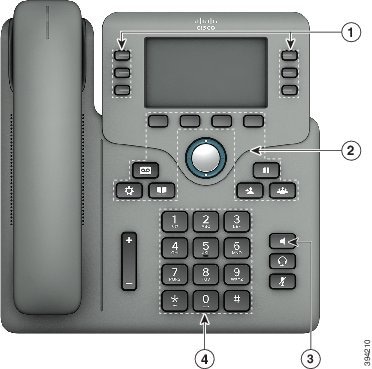
|
Item |
Accessibility Feature |
Description |
|---|---|---|
|
1 |
Lighted buttons |
Allow you to access the following features:
Indicate your phone's status:
|
|
2 |
Large buttons to access Applications, Messages, Contacts, Hold, Transfer, and Conference |
Allow you to easily access your phone applications, voice messages, corporate and personal directories, and calling features. |
|
3 |
Built-in speakerphone |
Indicates whether the speakerphone is on or off. When the speakerphone is on, the button is lit. |
|
4 |
Tactile-discernible buttons and functions, including a nib on Key 5 |
Allow you to easily locate your phone's keys. For example, Key 5 has a nib, which you can use to locate other key positions. |
Third-Party Accessibility Applications
Cisco works closely with partners to provide solutions that complement the accessibility and usability of Cisco products and solutions. There are third-party applications such as real-time captioning on Cisco IP Phones, Text Telephones for the Deaf (TDD/TTY), Real Time Text (RTT), hearing/voice carry over (HCO/VCO), audible caller ID, inline amplifiers for handsets for louder call sound, "busy lights", audio/visual emergency notifications through Cisco IP Phones (supporting users with disabilities), etc.
Here's a link to a presentation about all the accessibility features of Cisco Unified Communications products, and some third party assistive technology which works with it:
For more information about third-party applications, contact your administrator.
 Feedback
Feedback